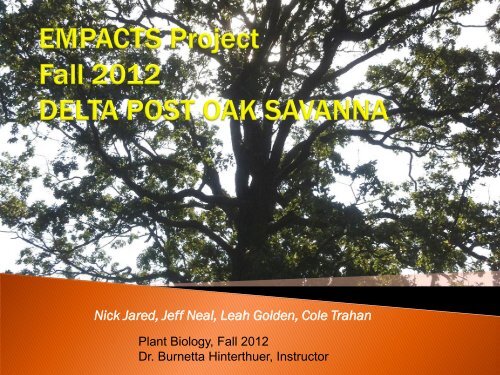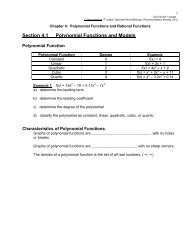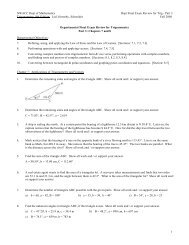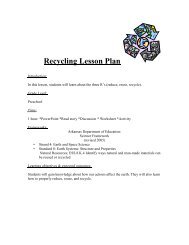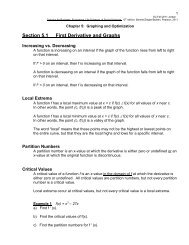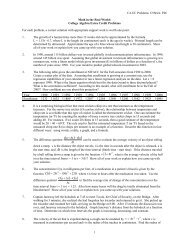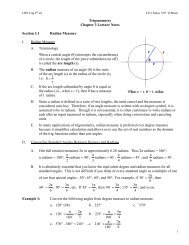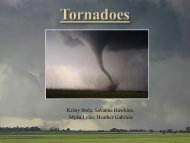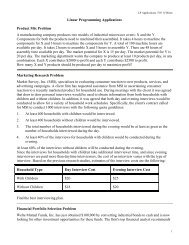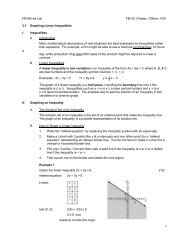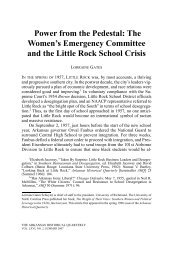Final Presentation - Faculty Web Pages - NWACC
Final Presentation - Faculty Web Pages - NWACC
Final Presentation - Faculty Web Pages - NWACC
- No tags were found...
Create successful ePaper yourself
Turn your PDF publications into a flip-book with our unique Google optimized e-Paper software.
Nick Jared, Jeff Neal, Leah Golden, Cole TrahanPlant Biology, Fall 2012Dr. Burnetta Hinterthuer, Instructor
In 1998 Botanist John Logan and Ecologist Tom Fotiestablished the land behind <strong>NWACC</strong> as a SavannaBarrens Area. This area is a continued work inprogress as many EMPACT teams work season toseason to bring life and vigor back to it’s original floraand fauna as a prairie grassland.
The Post Oak Area Projectis crucial to NorthwestArkansas in the preservationof the Delta Post Oak,in conjunction with otherEMPACT teams workingdiligently to restore theNature Area back to it’soriginal prairiegrassland state.
As part of a larger Prairie Restoration Project at the<strong>NWACC</strong> Nature Area, our team will focus on thepreservation of the Delta Post Oak Savanna. Theprimary objectives of this project will be…Collect samples for proper identification and measurement data foreach tree.Classify Post Oaks and differentiate between Delta and CommonPost Oak.Map the distribution of Post Oaks within the Nature Area byidentifying and locating each tree using GPS coordinates.
Recognize conservation issues and sustainable practices formaintaining the health of the biosphere Use traditional and electronic resources to researchinformation Impassion our community through education of the Post OakSavanna ecosystem in the Ozarks. Use Geographic Information Systems to map the Delta PostOaks and Common Post Oaks in our Post Oak Savanna Follow all these objectives as stated in our Plant Biologysyllabus
It is also our goal toeducate the BentonCounty Boys and GirlsClub, TORCH CLUB, on site,of our work to begineducating our areas youngcitizens to increase apassion for science andspecies preservation. Our team has created 10photographs to display atmany local coffee shopsand the halls of <strong>NWACC</strong> tocreate awareness aboutthe rarity and beauty of ourDelta Post Oak Savanna,along with a brochure fordistribution at these sites. We educated ourcommunity by locating,and identifying the speciesand age of the Post Oaks,from the Delta Post Oak
We collected samples from an identified Delta Post Oak to dryand preserve as framed artwork to give to interested citizensfor the preservation of our Delta Post Oak Savanna. Thisoffering will increase awareness to the importance of caring forthis rare tree.
Diameter Tape Measure GPS Device Increment Bore Photography thruvideo and camera Microsoft Word/ Excel Powerpoint
Identify the rare species of DeltaPost Oak from the common PostOak. POST OAK- Quercus stellata DELTA POST OAK – Quercussimilis Using GPSIES software, createmaps Technology using Google Mapand GIS Imagery Learn techniques to extract andprepare a sample for reading Document location, tagnumbers, diameter andcircumference of Post Oaks inExcel spread sheetusing GPS
Through this project weidentified the 40 tagged PostOaks in <strong>NWACC</strong>’S livinglaboratory by taking qualitysamples.We documented thecoordinates of the 40 taggedtrees along with theirindividual tree tag number formore thorough identification.We located and taggedanother 54 oaks in the<strong>NWACC</strong> Nature Area usingGPS way points anddocumented coordinates,along with taking some qualitysamples to determine whichtrees are Delta Post Oaks.Once coordinates weredocumented, we measuredcircumference and diameterof each tagged tree using adiameter tape measure.
Our team documented all our findings on our web page sofuture <strong>NWACC</strong> teams can benefit from this informationand build upon it rather than having to start from scratch.<strong>Final</strong>ly, we will determine the age of several of the DeltaOaks using an Increment Bore.
Power Point/ writing ,organizing, and documenting data/Educating our youth: Leah Golden GPS, locating coordinates, GIS Imagery and maps: Jeff Neal Sample gathering: Cole Trahan, and Nick Jared Pressing and drying samples: Jeff Neal,Leah Golden Research for Increment Boring: Cole Trahan, and NickJared Tree tagging: Entire team
SKILLS: As a result of this project, our team was ableto develop and apply new skills. Communication: We learned how to communicate in such away that we discovered each members strengths andweaknesses. By doing this we were able to play to ourstrengths and adapt to prevent our individual weaknessesfrom effecting the progress of our project. Interpersonal: We learned to trust each other. If one of ussaid we would get a job done, than we trusted that teammember to follow through and do it.
Time Management: We learned to be flexible to each others crazyschedules and accomplish our goals regardless of time constraints. Field Sampling Techniques: Several new skills we learned were howto collect quality samples, tag trees, take diameter and circumferencemeasurements correctly, how to use GIS imagery to map the Post OakSavanna Area. Data Interpretation :We learned how to better identify the Delta Post Oak from theCommon Post Oak.Our team gained a better understanding of how to find the age of atree through increment bore samples.
Computer Technology: General: We honed our PowerPoint presentation skills and learned howto set up a web page for our project. Project Production: Graphic Design and ArtCollectively we learned how to take pictures as a visual representation of ournew found skills.Several of these pictures were utilized to create artwork to display oncampus and in local coffee shops for further awareness.Our team created and distributed brochures of our project to the community.Our team produced a poster for the EMPACTS Program and for the PlantBiology Class GIS – Learned to map the distribution of Oak trees in the <strong>NWACC</strong>Nature area.
Dr. Hinterthuer- Plant Biology Professor at <strong>NWACC</strong> Paul Lowery- <strong>NWACC</strong> Instructor Dr. Marvin Galloway- Dean of Math and Science depts. @<strong>NWACC</strong>, EMPACTS Coordinator Daniel Rodriguez, Boys and Girls Club of Benton County Professor C. Dianne Phillips, EMPACTS Project Facilitator
‣ Paul Lowrey, GIS Imagery Specialist‣ Dr. Marvin Galloway, Dean of Science andMathematics‣ Dr. Burnetta Hinterthuer, Plant Biology Instructor‣ C. Dianne Phillips, EMPACTS Project Facilitator
‣ Posters of Delta Post Oaks, framed and hung in area coffeeshops, and college hallways‣ Framed leaf specimens of Delta Post Oak trees to distributeto the Delta Post Oak Society‣ <strong>Web</strong>page‣ <strong>Final</strong> <strong>Presentation</strong> – Power Point describing experience‣ Collecting “quality” laboratory samples for further study
ATTACH LINKS TO MAPS, BROCHURES, IMAGES,WEBLINKS,ETC. See webpage for links


